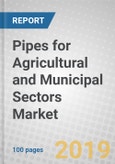This study provides in-depth coverage of many of the most important economic, technological, political, regulatory and environmental considerations associated with the global markets for the production and use of various types of pipes in the municipal and agricultural sectors. Pipes are made from materials ranging from inorganic clays and concrete to iron and steel and to commodity and specialty polymers. This study focuses on all types of pipes used for water distribution, wastewater, and irrigation.
This report includes key technologies (and new technologies), the markets and some key companies that make up the industry, and all of their ramifications.
Demands are estimated for the base period of 2017 and 2018 and forecast for five years through 2023. All market volume figures usually are rounded to the nearest billion in U.S. dollars. All five-year growth rates are compounded and signified as compounded annual growth rates (CAGRs). The estimates are based on manufacturers’ total revenues. Because of this rounding, some growth rates may not agree exactly with figures in the market tables, especially for differences in small volumes.
The Report Includes:
- 45 data tables
- A detailed overview and industry analysis of global markets for pipes for agricultural and municipal sectors
- Analyses of global market trends with data from 2017 to 2018, and projections of compound annual growth rates (CAGRs) through 2023
- Regional dynamics of the global pipe industry (municipal and irrigation pipes) covering five major regions North America, Europe, APAC, LATAM and MEA
- Historical perspective of the piping industry, materials used in the production of these pipes, their applications and unique properties, and dimensions of common pipes
- Information on major drivers and regional dynamics of polyethylene pipes market and current trends within the industry
- Discussion of environmental and governmental regulatory issues and factors that affect the piping industry, with emphasis on important codes, standards and related factors
- An analysis of patents issued to various companies for related technologies and new developments in piping technology
- Company profiles of the leading market players, including Amiantit Group, Endot Industries Inc., Jindal SAW Ltd., National Pipe & Plastics Inc., Saint-Gobain PAM, U.S. Pipe and Wienerberger
Table of Contents
Executive Summary
The water and wastewater pipe industry is very large, and it includes pipes made from many different materials, all of which compete with each other to various degrees depending on the region and country.
These materials include:
- Clay: Clay is an old material that has been used for years both for potable water transmission and for sewers and other drains. Today, clay has essentially been overtaken by other materials and is only used in any volume for gravity sewers.
- Concrete pipe: Both non-pressure pipe for gravity sewers and drains and concrete pressure pipe (CPP) are used for water transmission and pressure sewers. Concrete pipe tends to be used in very large diameter applications and is seeing increased competition from large diameter plastic piping.
- Cast iron pipe: Cast iron pipe involves both ductile iron used for pressure water mains and sewers, and gray iron used for drain, waste and vent (DWV) piping. Cast iron is strong and durable but in recent years has lost market share in the water transmission market to other materials, especially plastics.
- Steel pipe: Steel still is probably the most versatile and accepted pipe material, and it is used in many applications.
- Plastic pipes: These are made from several types of thermoplastic (TP) resins, including ABS, fluoropolymers, polyethylenes (mostly HDPE), polypropylene and vinyl polymers (polyvinyl chloride or PVC and its polychlorinated analog CPVC). Commercial piping also includes fiberglass-reinforced pipe (FRP) made with thermosetting (TS) resins. PVC/CPVC is by far the most-used piping plastics, followed by polyethylenes HDPE. Plastics are increasingly being used due to their corrosion resistance, low weight, low cost and endurance. They have taken market share from other piping materials, and the publisher believes they will continue to do, although at a slower rate than in the past.
Over the past decade, the industry has continued to use the same materials, essentially for the same applications. The change that has occurred is that older piping materials are being replaced by plastic resins, especially high-density polyethylene (HDPE) and polyvinyl chloride (PVC).
Newer technology continues to focus on the trenchless method, a technique that can repair an old pipe or install a new one without having to excavate and prepare a bed for a new pipe and then install the pipe and backfilling. Trenchless technology involves sliplining - that is, inserting a new liner, usually plastic, inside an older deteriorating pipe - and pipe bursting ahead of new pipe insertion.
Companies Mentioned
- Advanced Drainage Systems Inc.
- Aliaxis Group S.A./N.V.
- Amanco
- Amiantit Group
- Asahi/America
- Can Clay
- Charter Plastics
- Electrosteel Castings Ltd.
- Endot Industries Inc.
- Era/Yonggao Co. Ltd.
- Future Pipe Industries (FPI)
- GF Piping Systems
- Hobas
- Jindal Saw Ltd.
- Jm Eagle
- Kubota
- Lesso
- Mcwane
- National Pipe & Plastics Inc.
- North American Pipe Corp.
- Northern Pipe Products Inc.
- Northwest Pipe Co.
- Performance Pipe
- Saint-Gobain Pam
- Sekisui Chemical
- U.S. Pipe
- Water Transmission Group (WTG)
- Wavin
- Wienerberger Ag
- Xinxing








